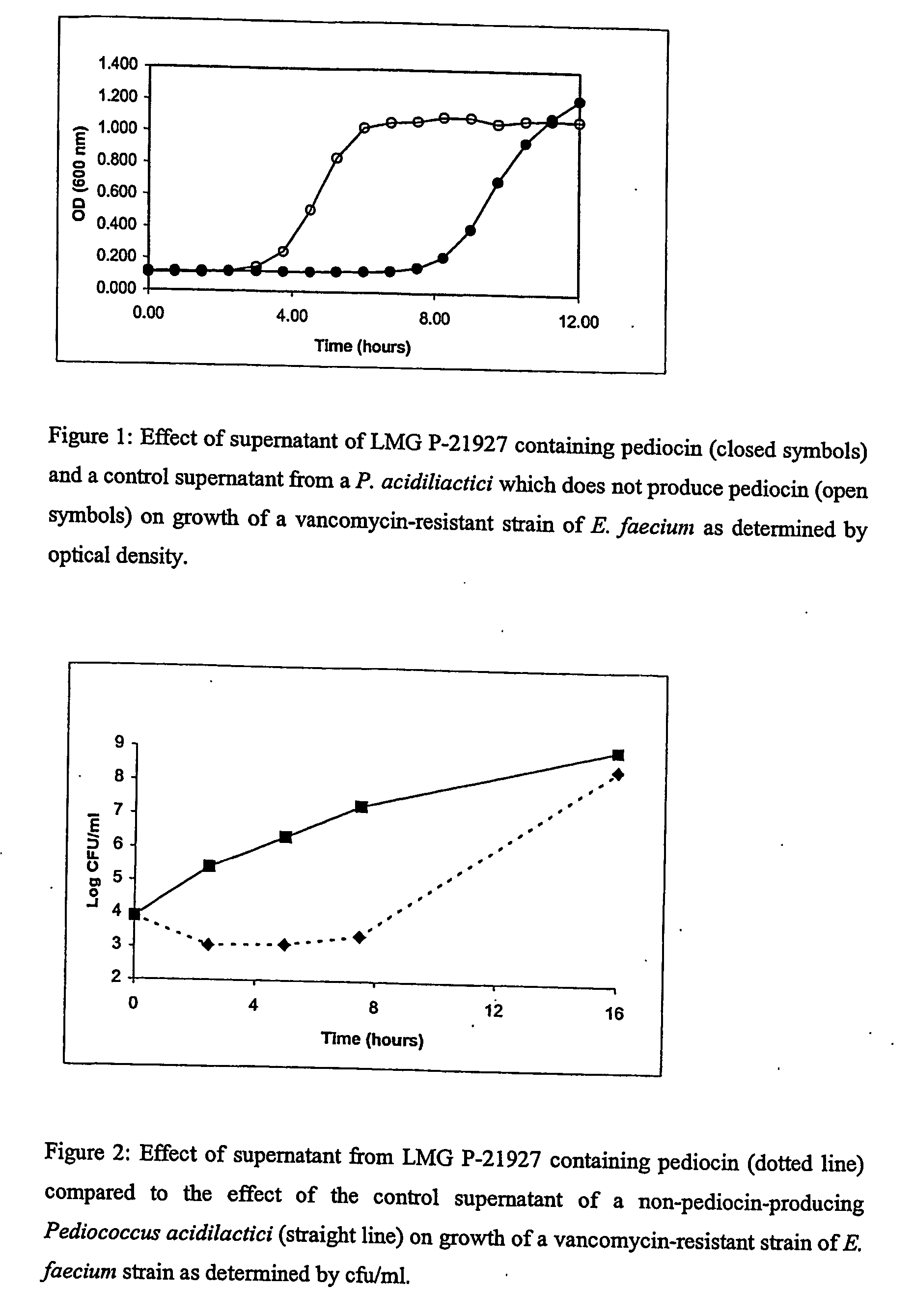Pediocin-producing pediococci
a technology of pediocin and pediocin, which is applied in the field of pediocin-producing pediocin, can solve the problems of bacteriocins having the same spectrum of activity, starting to build up a certain, and disturbance of intra-cellular homeostasis
- Summary
- Abstract
- Description
- Claims
- Application Information
AI Technical Summary
Benefits of technology
Problems solved by technology
Method used
Image
Examples
example 1
Survival in Static Stomach and Small Intestine Model
[0074] The survival in the stomach and small intestine of P. acidilactici isolated from human faeces LMG P-21927 as well as known probiotic strains was evaluated. The survival of the pediococci in the stomach and small intestine is important when the strain is used as a probiotic in humans. Besides P. acidilactici LMG P-21927, known Pediococcus strains were tested: P. acidilactici ATCC 8081, P. acidilactici P-2 from a starter culture for meat fermentation from Christian Hansen, which P-2 produced pediocin, and P. acidilactici DSM 20284.
[0075] The bacteria were grown in MRS for 24 hours and subsequently re-inoculated for 18 hours in MRS. 1 ml of the grown culture was added to 9 ml of the stomach medium, consisting of 8.3 g / l bacteriological peptone, 3.1 g / l NaCl, 0.11 μl CaCl2, 1.1 g / l KCl, 0.6 g / l KH2PO4, 22.2 mg / l pepsin and 22.2 mg / l lipase, pH 3.0. The bacteria were incubated for 3 hours at 37° C. in the stomach medium. Afterw...
example 2
[0077] The P. acidilactici strains LMG P-21927, P-2, ATCC 8081 and DSM 20284 were grown in MRS for 24 hours and subsequently re-inoculated for 18 hours in MRS. The grown culture was 10 times diluted in PPS (Peptone physiological salt solution) (8.5 g / l sodium chloride, 1 g / l bacteriological peptone). 1 ml of this dilution was added to 9 ml of small intestine medium without pancreatin, with 5.5 or 1.1 g / l bile and incubated for 3 hours at 37° C. Samples were taken at t=0, and 3 hours and plated on MRS agar to determine the colony forming units. Results showed LMG P-21927 survived the small intestine with different bile salt concentrations better than the other pediococci (Table 4). This indicates that a pediococcus isolated from human faeces has better probiotic properties than a pediococcus isolated from food, meat and plants, since it has an improved ability to survive the conditions of the small intestine.
TABLE 4Survival (in % of the colony forming units) of pediococci in smalli...
example 3
Growth on Prebiotics
[0078]P. acidilactici LMG P-21927 was grown in MRS for 24 hours and subsequently re-inoculated for 18 hours in MRS. Cultures were harvested by centrifugation (10 minutes 4000 rpm, Sorval RT 17) and the pellet was washed with and resuspended in PPS. This step was repeated. M17 medium (Oxoid) was prepared and different fibres were used as carbon source. The different M17 media were inoculated with 1% with the washed bacteria and incubated during 24 hours at 37° C. During incubation the optical density was measured. Results showed that P. acidilactici LMG P-21927 could grow on: trans-galactooligosaccharides (0.5% w / v), hydrolysed locust bean gum (0.5% w / v) and inulin, fructo-oligosaccharides and hydrolysed inulin (0.5% w / v).
PUM
| Property | Measurement | Unit |
|---|---|---|
| Fraction | aaaaa | aaaaa |
| Fraction | aaaaa | aaaaa |
Abstract
Description
Claims
Application Information
 Login to View More
Login to View More - R&D
- Intellectual Property
- Life Sciences
- Materials
- Tech Scout
- Unparalleled Data Quality
- Higher Quality Content
- 60% Fewer Hallucinations
Browse by: Latest US Patents, China's latest patents, Technical Efficacy Thesaurus, Application Domain, Technology Topic, Popular Technical Reports.
© 2025 PatSnap. All rights reserved.Legal|Privacy policy|Modern Slavery Act Transparency Statement|Sitemap|About US| Contact US: help@patsnap.com

